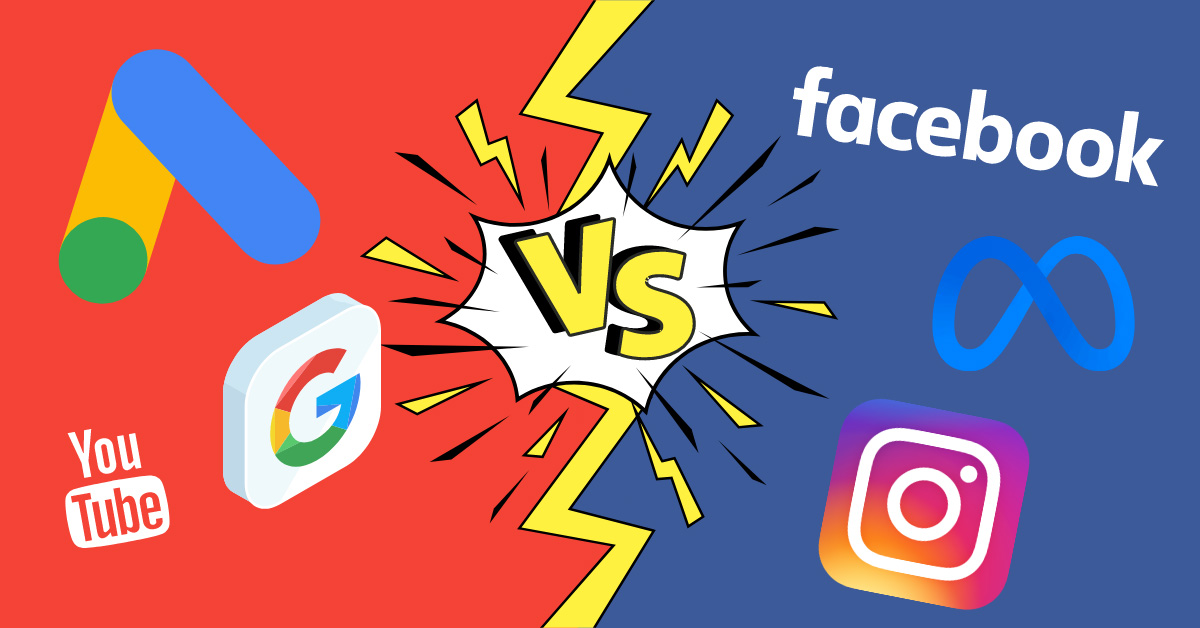In this article, we’ll help you choose the best advertising platform for your business.
One question we’re often asked by new clients is “Which platform should I invest in, Google Ads or Facebook Ads?”
Well here’s the kicker: never start with the platform.
Before thinking about a platform, ask yourself the following questions:
- How do current customers find their website?
- What acquisition channels currently generate high-quality traffic?
- What keywords do potential customers use to find the product on Google?
- Is the target audience well defined and who is the primary buyer?
- How does the target audience spend time online? For example, do they live on social media or browse the web from a mobile? What kind of apps do they use? Do they use YouTube or Gmail regularly?
- How long does it take before customers make a purchase?
- Is there a newsletter subscriber database?
- What is the budget for the initial advertising strategy? Is this budget sustainable for the business and will it provide enough data to assess growth?
- What are the best selling products/services that can be promoted first to generate the greatest profit in the short-term?
Making an informed choice in the first instance avoids costly mistakes that can lead to poor results and cause you to lose confidence in your strategy and the people implementing it.
To set up an advertising strategy, it’s important to understand the following concepts: conscious demand and latent demand.
Conscious Demand
Think about your brand or the product or service you want to promote.
How do your potential customers find you online? If you have a known brand or a known type of product or service then you have conscious demand.
Let’s take an example: A new company is trying to break into the cereal-market, specifically selling organic breakfast cereals, like granola.
Most users on Google will probably not search for that company by its brand name. Instead, the target audience will search for similar products, using keywords like “granola with organic chocolate,” “protein granola”, and “gluten-free granola”.
In this case, there is a conscious demand for the product, and the company can intercept it thanks to a Google campaign on the Search Network, with the use of keywords and shopping campaigns.

The ability to appear for specific user searches and show products and services that reflect these searches is Google’s strongest point.
Therefore, if there is a conscious demand for your business, your brand, your product, or your service, you should include Google Search campaigns (and Google Shopping, in case of e-commerce) in your advertising strategy.
Latent demand
In contrast to conscious demand, latent demand refers to a target audience that may be interested in your product or service but are not actively searching for it.
These users might have the same problem to solve as someone doing a Google search, but we simply try to reach them at another time — when they’re on their favourite websites, social media, or even YouTube or Gmail.
Advertising campaigns on Social Networks, Display Networks, YouTube and Gmail (through photo, video and product ads) aim to capture the attention of your target market and lead them to yourwebsite where they can purchase your product, or ‘convert’.
Types of advertisements
Facebook and Google’s advertising platforms encompass a range of different tools that allow them to reach users at various stages of their customer journey, thus succeeding in responding to conscious demand or stimulating latent demand.
To better understand the similarities and differences between the two platforms, here are the types of ads you can create and the different placements:
- Video ads: Facebook, Instagram, Audience Network, YouTube
- Ads with photos: Facebook, Instagram, Audience Network, Google Display, Gmail
- Ads with product catalogue: Facebook, Instagram, Audience Network, Google Shopping
- Text ads: Google Search
Each of these can be used at a different stage of the customer acquisition funnel. That is, the path we want the user to take from the moment they first discover our brand until they reach a conversion action, such as filling out a form or making a purchase.
Now that the concepts of conscious demand and latent demand are clear, we can organise the tools of both platforms in this way:
Conscious Demand
Google Search Ads
Google Shopping Ads
Latent demand
This simple table helps you understand which tools are best for intercepting conscious demand, and which ones aim to stimulate latent demand.
If you have clear answers to the questions we asked about your business above, you will be able to better evaluate which tool will better serve your business.
But, Google Ads is not just about search
Google Ads is best known for advertising campaigns on the Search Network. This is because it remains Google’s strongest point and because everyone associates Google immediately with the search engine they use every day.
However, Google Ads has been in high demand in recent years, which is why it’s important to take it into consideration even when we want to focus on stimulating latent demand.
Saying Google Ads equals conscious demand and FacebookAds equals latent demand is no longer 100% true.
In fact, the advanced tools of Google’s Display Network now work well on latent demand thanks to Display, YouTube, Gmail and the new Discovery campaigns. Google knows what stage of a acquisition a user is in based on their online behaviour, and can display appropriate ads for each stage – even suggesting your product before they are actively looking for it.
This aspect is crucial and has to be considered during strategic development because referring only to a single tool can be risky and, in the long run, not sustainable.
In Conclusion
There is no magic formula that allows you to decide which platform to choose, but if you focus on your target audience, on conscious and latent demand, and on the tools that each platform makes available, you can make wise choices that will grow your business, both in the short and long term.
If you’d like some more help, get in touch with AS Digital today.

